From alleviating pain, inflammation, and depression to encouraging a youthful complexion, LEDs and lasers offer a drug-free, precisely targeted therapy with minimal reported side effects.
MARIE FREEBODY, CONTRIBUTING EDITOR
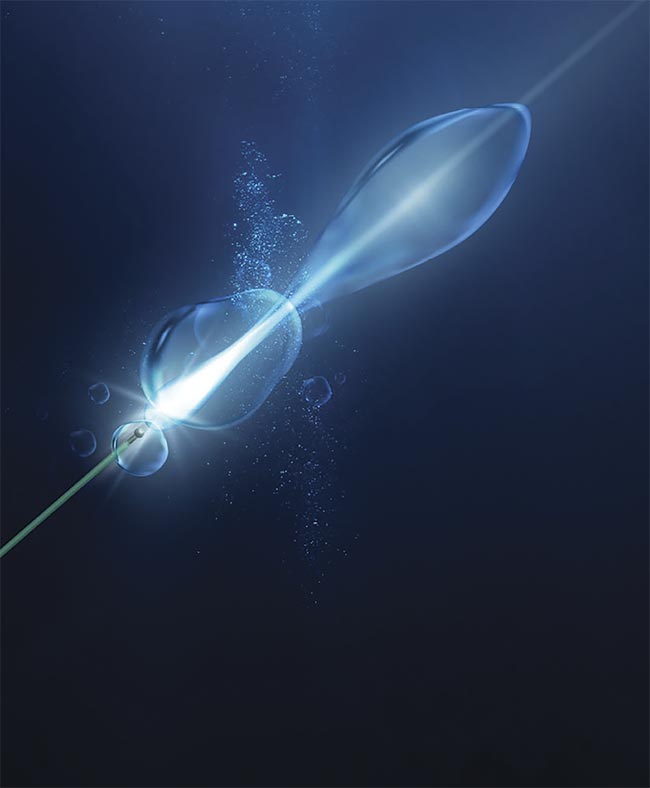
Almost as soon as the first working laser was built in 1960 by Theodore Maiman, reports from users of lasers multiplied regarding the curious effects that light can elicit on living tissue. In 1962, dermatologic surgeon Leon Goldman reported the successful laser removal of unwanted skin markings, specifically tattoos. Fast forward to today, and similar techniques are used to erase birthmarks and pigmentation as well.
In 1967, professor Endre Mester at Semmelweis Medical University in Hungary wondered whether laser beams might cause skin cancer because early radiologists were developing the disease on their hands when exposed to x-rays.
Mester performed an experiment on two groups of shaved mice, aiming a low-powered ruby laser at one group and not the other, to see whether the treatment group would develop cancer. To Mester’s astonishment, not only did the treatment group not develop cancer but this group’s hair grew back more quickly. This became one of the first examples of laser biostimulation.
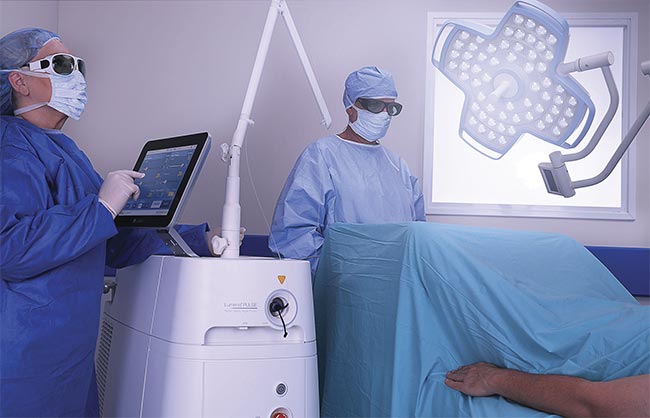
An all-in-one urology laser platform such as the MOSES technology can be used in the operating room to fragment stones throughout the entire urinary tract, targeting kidney, ureteral, and bladder stones. Modulated laser pulses ‘part the water’ by creating a small vapor bubble through which a consecutive laser pulse travels unimpeded to the targeted stone or tissue. Courtesy of Lumenis.
“In contrast to pharmacological therapy, laser therapy is safe, has few side effects, and is local,” said Mei X. Wu, a professor from the Wellman Center for Photomedicine at Massachusetts General Hospital. “However, it must be applied to the right disorder at the right place and at the right time and frequency to be effective.”
Lasers can improve the function of certain types of cells — such as neurons and muscle and immune cells — by enhancing the processes inside the cells, including conversion of oxygen and nutrients, and transporting of electrons. Moreover, lasers are wavelength-specific, so intensity, beam size, pulse regime, and fluence can be controlled to treat various areas of the body uniquely, which may not be the case with treatments such as massage or physiotherapy.
Range of therapies
Some proven and widely accepted applications of laser-based medicine include ophthalmologic treatments, tissue ablation, tattoo removal in dermatology, photodynamic therapy in various medical fields, endovenous laser light application for varicose vein treatment, and laser treatment of teeth for caries, ablation, and root channel disinfection. Light intervention in the field of aesthetic-cosmetic medicine is a rapidly growing market, and a new trend to watch is wellness (see sidebar “Skin Deep: The Beauty of Light Therapy”).
Innovative research is flourishing in numerous areas of application. There are breakthroughs not only in the technology applied in existing medical procedures, but also in emerging treatments set to benefit from the techniques for the first time.
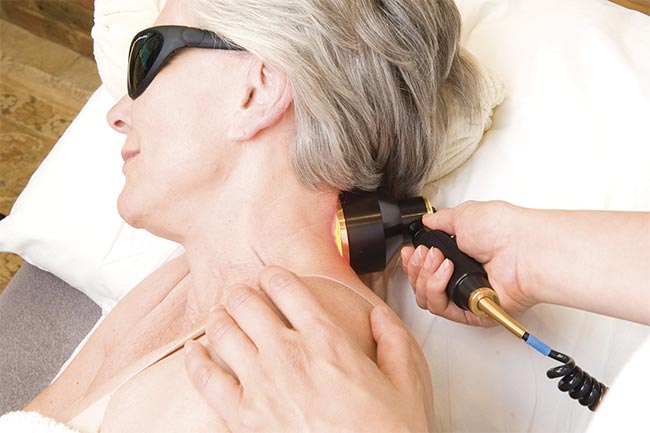
PBM treatment of neck pain. A typical session takes 10 minutes. Courtesy of THOR Photomedicine.
“Neonatal hyperbilirubinemia has been routinely treated with blue light for more than 40 years in clinics,” Wu said. “Millions of newborns have received blue light treatment with no safety concerns, and this remains the most successful treatment.”
Another affliction that occurs — particularly in premature babies — is retinopathy caused by oxygen toxicity. Trials to treat it using red-light therapy are taking place at Australian National University Medical School and Centenary Hospital for Women and Children, Canberra Hospital, in Australia. At the Center for Vision Research in the Department of Ophthalmology at the State University of New York Upstate Medical University in Syracuse, N.Y., red-light therapy may also be tested to treat methanol-induced retinal damage, diabetic retinopathy, and age-related macular degeneration and cognition.
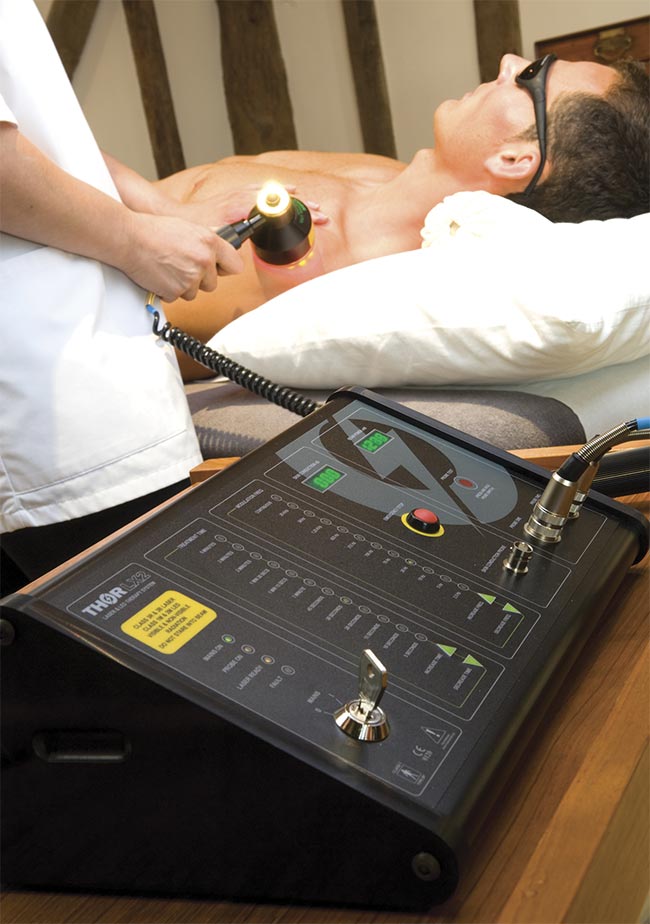
PBM treatment of shoulder pain. A typical session takes 10 minutes. Courtesy of THOR Photomedicine.
Red and/or near-infrared light has been a reliable therapy for decades to treat back pain, and it has also been shown to accelerate wound healing, stimulate hair growth, and alleviate arthritis. It can be used to manage various skin infections.
In urology, holmium lasers are routinely used to fragment and remove urinary (bladder, kidney, and ureteral) stones through flexible ureteroscopy (fURS), retrograde intrarenal surgery (RIRS), or mini-percutaneous nephrolithotomy (mini-PCNL), and urological surgeons consider lasers the gold standard for these treatments. Recently, medical device manufacturer Lumenis introduced its MOSES technology, which uses a unique pulse modulation for faster and more efficient procedures.
Yaniv Nir, product director at Lumenis’ subsidiary in San Jose, Calif., said that in urology care, the holmium technology produces 20% faster procedures, a 25% reduction in fragmentation time, and 60% less retropulsion.
And an emerging sector is growing that takes advantage of much lower-energy light. Photobiomodulation (PBM) is breaking new ground in treating neuropathic pain such as that associated with shingles, postherpetic neuralgia, trigeminal neuralgia, diabetic peripheral neuropathy, chemotherapy-induced peripheral neuropathies, and hard-to-heal wounds such as diabetic ulcers, venous ulcers, and pressure sores.
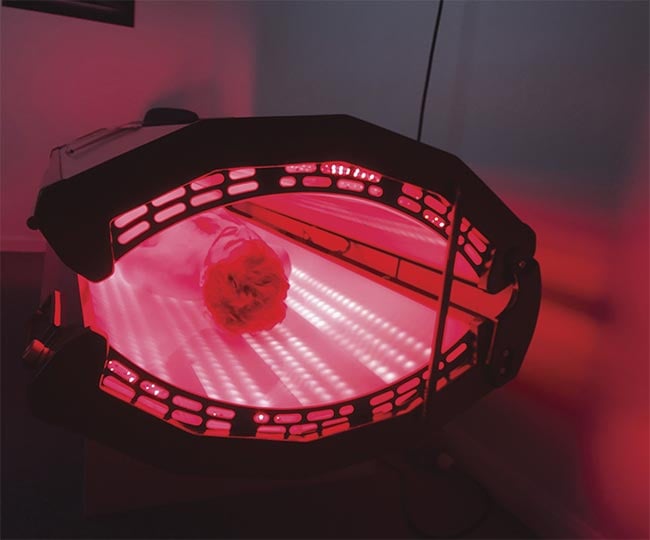
NovoTHOR whole-body treatment system. A typical session takes 15 minutes. Courtesy of NovoTHOR.
But according to Scot Faulkner, a leader at the PBM Foundation, the applications closest to the finish line are for treating oral mucositis and age-related macular degeneration, the leading cause of blindness in the developed world.
Oral mucositis is a painful and sometimes debilitating side effect brought about by high-dose chemotherapy or radiation treatment. Typically, patients report that symptoms begin five to 10 days after starting chemotherapy, or 14 days after starting radiotherapy, and they describe mouth sores that can feel like burns. In severe cases, patients can no longer swallow food.
It is light’s propensity to promote wound closure, reduce inflammation, and stimulate healing at the surface of tissue that is central to its success. Light improves energy production in cells by stimulating their mitochondria, which can absorb light and use it to increase energy production and reduce the free radicals that cause inflammation and cell death. Under these circumstances, tissues heal and become more resilient.
Scientists at Tel Aviv University in Israel are taking these healing effects deeper into the body with a PBM device for stimulating bone marrow. This process leads to an increased production of stem cells that can turn into different types of blood cells to help the body repair.
“They [the stem cells] circulate in the bloodstream to areas of the body where there may be an injury,” Faulkner said. “It has been shown in a human clinical trial that this technique reduces the blood biomarkers for heart muscle damage.”
PBM could even form part of the solution to tackling the opioid crisis, which currently grips the U.S. and is a growing concern in other countries, such as the U.K. Opioids have frequently been prescribed to treat chronic pain and were once mistakenly thought to be nonaddictive.
Three features are typically present in opioid use disorder, all of which PBM could address. The technique reduces pain (diminishing the usual reason for the initial use of opioids), is regenerative (it helps heal the underlying cause of the pain), and decreases some of the psychological components of the disorder (depression and anxiety).
“Most sufferers who develop substance use disorders end up having both a physical pain and a psychological condition,” Faulkner said. “PBM addresses these components.”
Rise of LEDS
In the last decade, the PBM landscape has shifted away from lasers and toward LED arrays. Although lasers can achieve higher power density levels and may be more useful for reaching tissues deep within the body — the spine and joints, for example — they generally cannot deliver sufficient energy as easily as LEDs. Lasers also come with safety and cost issues.
“The main skepticism and resistance to laser therapy is due to high laser safety standards, which must be kept in mind when using lasers in the operating room — for example, the need for laser safety officers, specifically trained nurses, laser safety tools, and so on,” said Juergen Popp, the scientific director at the Leibniz Institute of Photonic Technology (IPHT) in Jena, Germany.
“This also leads to overcoming big hurdles to fulfill the criteria for an FDA or Medical Device Regulation approval, which is becoming more and more difficult these days. In addition, the economic aspect must be also considered, including equipment costs, maintenance costs, laser training, laser safety equipment, and disposable products such as fibers and probes,” he said.
But LED use is not without its own share of challenges. LEDs, particularly large flexible arrays that treat the whole body, are desirable, but according to Faulkner, the products available in today’s market lack reliability due to stress and fatigue, and they also lack sufficient power density. Even assuming that these issues can be overcome, the next challenge would be addressing excessive heat that is generated in their use.
More research, investment
Despite its long history of clinical benefits, phototherapy is still in its infancy and remains significantly underdeveloped. This is in part because it is so easy to apply, resulting in extensive abuse. Subsequently, negative effects, or no effects at all, lead to skepticism and resistance.
Nevertheless, market demand is high. Michael R. Hamblin, associate professor of dermatology at Harvard Medical School and principal investigator at the Wellman Center for Photomedicine, both located in Boston, predicts that the appeal of home-use medical treatments will drive a rise in LED devices.
“The future will probably concentrate on powerful LED arrays, including whole-body light beds and large panels with up to 50 W of optical power,” Hamblin said. At sports training centers, light beds are gaining popularity for promoting quicker muscle and tissue recovery and pain relief.
Developing precision phototherapy remains a significant challenge. The Wellman Center’s professor Wu expects significant progress may take another 10 to 20 years.
Although there are a lot of enthusiastic physicians and researchers in this field, the education of young physicians about the usefulness of PBM must also be addressed before the treatment can take its place as a mainstream option.
“The curriculum of most medical courses does not take laser treatment into consideration,” said Ronald Sroka, senior member of the laser research lab at the LIFE Center in the University of Munich’s (LMU’s) medical center. “Potentially, the upcoming generation may have more knowledge about this interesting technological field.”
What’s in a Name?
When it comes to how light-based therapy is classified, nomenclature has been hugely diverse. Up until the end of 2017, the leading term on PubMed was “low-level laser therapy” or “low-light therapy,” or “LLLT” for short. However, it was widely agreed that this terminology did not appropriately reflect the range of techniques involved, partly because the source of the treatment doesn’t have to be laser light for the therapy to work.
The term “photobiomodulation” (PBM) was adopted by the U.S. National Library of Medicine in 2018 and became the leading term for this therapy on the U.S. National Institutes of Health’s medical database, PubMed.gov. Explicitly, “photo” means light, “bio” means life, and “modulation” means to stimulate or inhibit.
Despite mounting evidence of its effectiveness, the FDA does not currently recognize the term “photobiomodulation” in its issuance of product codes, which means there is no medical insurance reimbursement for it — or the equivalent within countries offering socialized medical health care. These hurdles must first be cleared before hospitals can include PBM in standard care procedures.
Preparing a robust future for PBM will also require more clinician training, and currently, no university-accredited courses exist in this area. Today, the PBM Foundation is working with the FDA to establish a code for the technique, as well as with a university in Paris to develop an accredited postgraduate course for doctors. Similarly, the foundation is working with a nursing school in the U.S. to include PBM therapy as part of its standard curriculum.
Skin Deep: The Beauty of Light Therapy
Pressure for the perfect look, driven by the increasing use of social media and digital apps, has been a boon for the aesthetics market. Medical devices and cosmetic specialists have seen more demand from patients who simply want to look better.
According to Mickey Nave, the director of corporate marketing at Lumenis, users want to look great in more than just their social media images but also in their daily lives. Nave highlights the “I’m worth it” concept as an emerging driver for people seeking elective procedures out of a desire to live life to the fullest and celebrate themselves.
Photobiomodulation (PBM) is not the same as cosmetic surgical lasers, which are used for hair removal, skin resurfacing, pigmentation and wrinkle reduction, tattoo removal, and scar and vascular lesion treatment. PBM is used by some cosmetic clinics to offer noninvasive skin regeneration and other enhancing therapies — including improving the appearance of acne, psoriasis, and eczema — during clients’ lunch breaks.
The “biohacking” and wellness markets are other emerging markets for PBM. Research shows that PBM improves muscle strength and endurance and recovery after exercise. The treatment is used by Nike and many sports teams (including those in the NFL, NBA, NHL, and MLB).
At this time, data for improved wellness is not documented. However, recent laboratory studies have shown that PBM reduces oxidative stress — free radicals that can lead to diseases associated with aging. Scot Faulkner, a leader at the PBM Foundation, believes that the claim of improved wellness is reasonable to make, assuming adequate power density, irradiation time, and sufficient body coverage. PBM could reduce oxidative stress and increase cellular energy, which would improve cell metabolism and reduce inflammation. “However, long-term studies to verify this would be required,” he said.